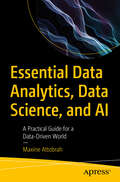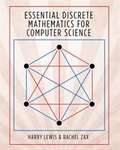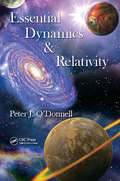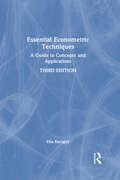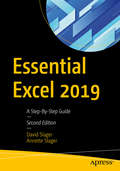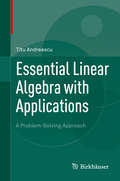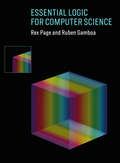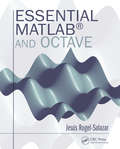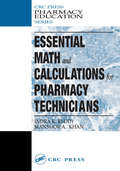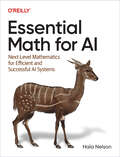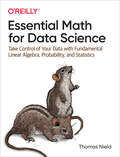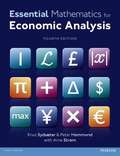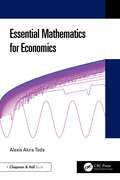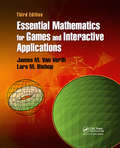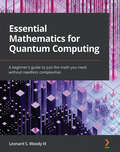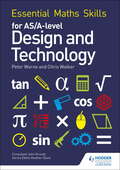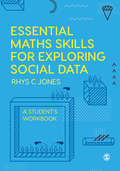- Table View
- List View
Essential Classical Thermodynamics (SpringerBriefs in Physics)
by Ulf W. GeddeThis book is a concise, readable, yet authoritative primer of basic classic thermodynamics. Many students have difficulty with thermodynamics, and find at some stage of their careers in academia or industry that they have forgotten what they learned, or never really understood these fundamental physical laws. As the title of the book suggests, the author has distilled the subject down to its essentials, using many simple and clear illustrations, instructive examples, and key equations and simple derivations to elucidate concepts. Based on many years of teaching experience at the undergraduate and graduate levels, “Essential Classical Thermodynamics” is intended to provide a positive learning experience, and to empower the reader to explore the many possibilities for applying thermodynamics in other fields of science, engineering, and even economics where energy plays a central role. Thermodynamics is fun when you understand it!
Essential Data Analytics, Data Science, and AI: A Practical Guide for a Data-Driven World
by Maxine AttobrahIn today’s world, understanding data analytics, data science, and artificial intelligence is not just an advantage but a necessity. This book is your thorough guide to learning these innovative fields, designed to make the learning practical and engaging.The book starts by introducing data analytics, data science, and artificial intelligence. It illustrates real-world applications, and, it addresses the ethical considerations tied to AI. It also explores ways to gain data for practice and real-world scenarios, including the concept of synthetic data. Next, it uncovers Extract, Transform, Load (ETL) processes and explains how to implement them using Python. Further, it covers artificial intelligence and the pivotal role played by machine learning models. It explains feature engineering, the distinction between algorithms and models, and how to harness their power to make predictions. Moving forward, it discusses how to assess machine learning models after their creation, with insights into various evaluation techniques. It emphasizes the crucial aspects of model deployment, including the pros and cons of on-device versus cloud-based solutions. It concludes with real-world examples and encourages embracing AI while dispelling fears, and fostering an appreciation for the transformative potential of these technologies.Whether you’re a beginner or an experienced professional, this book offers valuable insights that will expand your horizons in the world of data and AI.What you will learn:What are Synthetic data and Telemetry dataHow to analyze data using programming languages like Python and Tableau.What is feature engineeringWhat are the practical Implications of Artificial IntelligenceWho this book is for:Data analysts, scientists, and engineers seeking to enhance their skills, explore advanced concepts, and stay up-to-date with ethics. Business leaders and decision-makers across industries are interested in understanding the transformative potential and ethical implications of data analytics and AI in their organizations.
Essential Demographic Methods
by Kenneth W. WachterEssential Demographic Methods brings to readers the full range of ideas and skills of demographic analysis that lie at the core of social sciences and public health. Classroom tested over many years, filled with fresh data and examples, this approachable text is tailored to the needs of beginners, advanced students, and researchers alike. An award-winning teacher and eminent demographer, Kenneth Wachter uses themes from the individual lifecourse, history, and global change to convey the meaning of concepts such as exponential growth, cohorts and periods, lifetables, population projection, proportional hazards, parity, marity, migration flows, and stable populations. The presentation is carefully paced and accessible to readers with knowledge of high-school algebra. Each chapter contains original problem sets and worked examples. From the most basic concepts and measures to developments in spatial demography and hazard modeling at the research frontier, Essential Demographic Methods brings out the wider appeal of demography in its connections across the sciences and humanities. It is a lively, compact guide for understanding quantitative population analysis in the social and biological world.
Essential Discrete Mathematics For Computer Science
by Harry Lewis Rachel ZaxDiscrete mathematics is the basis of much of computer science, from algorithms and automata theory to combinatorics and graph theory. This textbook covers the discrete mathematics that every computer science student needs to learn. Guiding students quickly through thirty-one short chapters that discuss one major topic each, this flexible book can be tailored to fit the syllabi for a variety of courses. Proven in the classroom, Essential Discrete Mathematics for Computer Science aims to teach mathematical reasoning as well as concepts and skills by stressing the art of proof. It is fully illustrated in color, and each chapter includes a concise summary as well as a set of exercises. The text requires only precalculus, and where calculus is needed, a quick summary of the basic facts is provided. Essential Discrete Mathematics for Computer Science is the ideal introductory textbook for standard undergraduate courses, and is also suitable for high school courses, distance education for adult learners, and self-study. The essential introduction to discrete mathematics Features thirty-one short chapters, each suitable for a single class lesson Includes more than 300 exercises Almost every formula and theorem proved in full Breadth of content makes the book adaptable to a variety of courses Each chapter includes a concise summary Solutions manual available to instructors
Essential Dynamics and Relativity
by Peter J. O'DonnellEssential Dynamics & Relativity provides students with an introduction to the core aspects of dynamics and special relativity. The author reiterates important ideas and terms throughout and covers concepts that are often missing from other textbooks at this level. He also places each topic within the wider constructs of the theory, without jump
Essential Econometric Techniques: A Guide to Concepts and Applications
by Elia KacapyrNow in its third edition, Essential Econometric Techniques: A Guide to Concepts and Applications is a concise, student-friendly textbook which provides an introductory grounding in econometrics, with an emphasis on the proper application and interpretation of results. Drawing on the author’s extensive teaching experience, this book offers intuitive explanations of concepts such as heteroskedasticity and serial correlation, and provides step-by-step overviews of each key topic. This new edition contains more applications, brings in new material including a dedicated chapter on panel data techniques, and moves the theoretical proofs to appendices. After Chapter 7, students will be able to design and conduct rudimentary econometric research. The next chapters cover multicollinearity, heteroskedasticity, and autocorrelation, followed by techniques for time-series analysis and panel data. Excel data sets for the end-of-chapter problems are available as a digital supplement. A solutions manual is also available for instructors, as well as PowerPoint slides for each chapter. Essential Econometric Techniques shows students how economic hypotheses can be questioned and tested using real-world data, and is the ideal supplementary text for all introductory econometrics courses.
Essential Econometric Techniques: A Guide to Concepts and Applications
by Elia KacapyrNow in its third edition, Essential Econometric Techniques: A Guide to Concepts and Applications is a concise, student-friendly textbook which provides an introductory grounding in econometrics, with an emphasis on the proper application and interpretation of results.Drawing on the author’s extensive teaching experience, this book offers intuitive explanations of concepts such as heteroskedasticity and serial correlation, and provides step-by-step overviews of each key topic. This new edition contains more applications, brings in new material including a dedicated chapter on panel data techniques, and moves the theoretical proofs to appendices. After Chapter 7, students will be able to design and conduct rudimentary econometric research. The next chapters cover multicollinearity, heteroskedasticity, and autocorrelation, followed by techniques for time-series analysis and panel data.Excel data sets for the end-of-chapter problems are available as a digital supplement. A solutions manual is also available for instructors, as well as PowerPoint slides for each chapter.Essential Econometric Techniques shows students how economic hypotheses can be questioned and tested using real-world data, and is the ideal supplementary text for all introductory econometrics courses.
Essential Excel 2019: A Step-By-Step Guide
by David Slager Annette SlagerCreate, edit, sort, analyze, summarize, and format data as well as graph it in Excel 2019. Chock full of visuals, user-friendly instructions, and reader exercises, this in-depth guide makes it easy for you to get on the bandwagon taking advantage of this powerful software and what it can do. Essential Excel 2019 doesn’t mess around. It provides the most clear and concise, but complete, information you need to successfully use the expansive features of Excel in your work environment.The second edition of this soup-to-nuts book delivers essential how-to and reference information for users who are new to Excel, those who want to continue building their Excel skills, or anyone who wants to get up to speed on the latest changes and features in Excel 2019. It is heavy on the practical examples and light on the theory, providing a step-by-step process of what you need to do when you are working with Excel. You will begin with the basics, advancing as each chapter builds on knowledge from previous chapters. You will appreciate real-life examples and exercises that reinforce what you have learned, and upon finishing the book, you will have the confidence to use much more than the typical 10% that most people use in Excel. What You Will Learn Create amazing visualizations of your data Get up to speed on easy and accurate methods for entering data Extract the information you want from imported data; manipulate and format it to meet your needs Export your results to other programs or share with others in the cloud Organize, summarize, filter, and consolidate your data in multiple ways Audit, validate, and protect your data Who This Book Is ForAnyone new to Excel or looking to take better advantage of the advanced features of the platform
Essential Linear Algebra with Applications
by Titu AndreescuRooted in a pedagogically successful problem-solving approach to linear algebra, the present work fills a gap in the literature that is sharply divided between elementary texts and books that are too advanced to appeal to a wide audience. It clearly develops the theoretical foundations of vector spaces, linear equations, matrix algebra, eigenvectors, and orthogonality, while simultaneously emphasizing applications and connections to fields such as biology, economics, computer graphics, electrical engineering, cryptography, and political science. Ideal as an introduction to linear algebra, the extensive exercises and well-chosen applications also make this text suitable for advanced courses at the junior or senior undergraduate level. Furthermore, it can serve as a colorful supplementary problem book, reference, or self-study manual for professional scientists and mathematicians. Complete with bibliography and index, "Essential Linear Algebra with Applications" is a natural bridge between pure and applied mathematics and the natural and social sciences, appropriate for any student or researcher who needs a strong footing in the theory, problem-solving, and model-building that are the subject's hallmark.
Essential Logic for Computer Science
by Ruben Gamboa Rex PageAn introduction to applying predicate logic to testing and verification of software and digital circuits that focuses on applications rather than theory. Computer scientists use logic for testing and verification of software and digital circuits, but many computer science students study logic only in the context of traditional mathematics, encountering the subject in a few lectures and a handful of problem sets in a discrete math course. This book offers a more substantive and rigorous approach to logic that focuses on applications in computer science. Topics covered include predicate logic, equation-based software, automated testing and theorem proving, and large-scale computation. Formalism is emphasized, and the book employs three formal notations: traditional algebraic formulas of propositional and predicate logic; digital circuit diagrams; and the widely used partially automated theorem prover, ACL2, which provides an accessible introduction to mechanized formalism. For readers who want to see formalization in action, the text presents examples using Proof Pad, a lightweight ACL2 environment. Readers will not become ALC2 experts, but will learn how mechanized logic can benefit software and hardware engineers. In addition, 180 exercises, some of them extremely challenging, offer opportunities for problem solving. There are no prerequisites beyond high school algebra. Programming experience is not required to understand the book's equation-based approach. The book can be used in undergraduate courses in logic for computer science and introduction to computer science and in math courses for computer science students.
Essential MATLAB and Octave
by Jesus Rogel-SalazarLearn Two Popular Programming Languages in a Single VolumeWidely used by scientists and engineers, well-established MATLAB and open-source Octave are similar software programs providing excellent capabilities for data analysis, visualization, and more. By means of straightforward explanations and examples from different areas in mathematics, engine
Essential Math and Calculations for Pharmacy Technicians (Pharmacy Education Series)
by Mansoor A. Khan Indra K. ReddyAccurately calculating medication dosages is a critical element in pharmaceutical care that directly affects optimal patient outcomes. Unfortunately, medication dosage errors happen in pharmacies, in hospitals, or even at home or in homecare settings everyday. In extreme cases, even minor dosage errors can have dire consequences. Careful calculations are essential to providing optimal medical and pharmaceutical care. Essential Math and Calculations for Pharmacy Technicians fills the need for a basic reference that students and professionals can use to help them understand and perform accurate calculations. Organized in a natural progression from the basic to the complex, the book includes:Roman and Arabic NumeralsFractions and decimalsRatios, proportions, and percentagesSystems of measurement including household conversionsInterpretation of medication ordersIsotonicity, pH, buffers, and reconstitutionsIntravenous flow ratesInsulin and Heparin productsPediatric dosageBusiness mathPacked with numerous solved examples and practice problems, the book presents the math in a step-by-step style that allows readers to quickly grasp concepts. The authors explain the fundamentals simply and clearly and include ample practice problems that help readers become proficient. The focus on critical thinking, real-life problem scenarios, and the self-test format make Essential Math and Calculations for Pharmacy Technicians an indispensable learning tool.
Essential Math for AI: Next-Level Mathematics for Efficient and Successful AI Systems
by Hala NelsonCompanies are scrambling to integrate AI into their systems and operations. But to build truly successful solutions, you need a firm grasp of the underlying mathematics. This accessible guide walks you through the math necessary to thrive in the AI field such as focusing on real-world applications rather than dense academic theory.Engineers, data scientists, and students alike will examine mathematical topics critical for AI--including regression, neural networks, optimization, backpropagation, convolution, Markov chains, and more--through popular applications such as computer vision, natural language processing, and automated systems. And supplementary Jupyter notebooks shed light on examples with Python code and visualizations. Whether you're just beginning your career or have years of experience, this book gives you the foundation necessary to dive deeper in the field.Understand the underlying mathematics powering AI systems, including generative adversarial networks, random graphs, large random matrices, mathematical logic, optimal control, and moreLearn how to adapt mathematical methods to different applications from completely different fieldsGain the mathematical fluency to interpret and explain how AI systems arrive at their decisions
Essential Math for Data Science: Take Control of Your Data with Fundamental Linear Algebra, Probability, and Statistics
by Thomas NieldMaster the math needed to excel in data science, machine learning, and statistics. In this book author Thomas Nield guides you through areas like calculus, probability, linear algebra, and statistics and how they apply to techniques like linear regression, logistic regression, and neural networks. Along the way you'll also gain practical insights into the state of data science and how to use those insights to maximize your career.Learn how to:Use Python code and libraries like SymPy, NumPy, and scikit-learn to explore essential mathematical concepts like calculus, linear algebra, statistics, and machine learningUnderstand techniques like linear regression, logistic regression, and neural networks in plain English, with minimal mathematical notation and jargonPerform descriptive statistics and hypothesis testing on a dataset to interpret p-values and statistical significanceManipulate vectors and matrices and perform matrix decompositionIntegrate and build upon incremental knowledge of calculus, probability, statistics, and linear algebra, and apply it to regression models including neural networksNavigate practically through a data science career and avoid common pitfalls, assumptions, and biases while tuning your skill set to stand out in the job market
Essential Mathematical Methods for the Physical Sciences
by M. P. Hobson K. F. Riley"The mathematical methods that physical scientists need for solving substantial problems in their fields of study are set out clearly and simply in this tutorial-style textbook. Students will develop problem-solving skills through hundreds of worked examples, self-test questions and homework problems. Each chapter concludes with a summary of the main procedures and results and all assumed prior knowledge is summarized in one of the appendices. Over 300 worked examples show how to use the techniques and around 100 self-test questions in the footnotes act as checkpoints to build student confidence. Nearly 400 end-of-chapter problems combine ideas from the chapter to reinforce the concepts. Hints and outline answers to the odd-numbered problems are given at the end of each chapter, with fully-worked solutions to these problems given in the accompanying Student Solutions Manual. Fully-worked solutions to all problems, password-protected for instructors, are available at www. cambridge. org/essential"--
Essential Mathematics for Economic Analysis (Fourth Edition)
by Peter Hammond Knut Sydsaeter Arne StromThis text provides an invaluable introduction to the mathematical tools that undergraduate economists need. The coverage is comprehensive, ranging from elementary algebra to more advanced material, whilst focusing on all the core topics that are usually taught in undergraduate courses on mathematics for economists.
Essential Mathematics for Economics
by Alexis Akira TodaEssential Mathematics for Economics covers mathematical topics that are essential for economic analysis in a concise but rigorous fashion. The book covers selected topics such as linear algebra, real analysis, convex analysis, constrained optimization, dynamic programming, and numerical analysis in a single volume. The book is entirely self-contained, and almost all propositions are proved. Features Replete with exercises and illuminating examples Suitable as a primary text for an advanced undergraduate or postgraduate course on mathematics for economics Basic linear algebra and real analysis are the only prerequisites. Supplementary materials such as Matlab codes, teaching slides etc. are posted on the book website https://github.com/alexisakira/EME.
Essential Mathematics for Games and Interactive Applications
by James M. Van Verth Lars M. BishopExpert Guidance on the Math Needed for 3D Game ProgrammingDeveloped from the authors' popular Game Developers Conference (GDC) tutorial, Essential Mathematics for Games and Interactive Applications, Third Edition illustrates the importance of mathematics in 3D programming. It shows you how to properly animate, simulate, and render scenes and discus
Essential Mathematics for Political and Social Research
by Jeff GillEssential Mathematics for Political and Social Research addresses an educational deficiency in the social and behavioral sciences. This 2006 book was the first of its kind to specifically address the comprehensive introduction to the mathematical principles needed by modern social scientists. The material introduces basic mathematical principles necessary to do analytical work in the social sciences, starting from first principles, but without unnecessary complexity. The core purpose is to present fundamental notions in standard notation and standard language with a clear, unified framework throughout. Through examples and exercises, this book is intended to not only motivate specific mathematical principles and practices, but also introduce the way that social science researchers use these tools. The intended emphasis is on conceptual understanding of key principles and their subsequent application.
Essential Mathematics for Quantum Computing: A beginner's guide to just the math you need without needless complexities
by Leonard S. Woody IIIDemystify quantum computing by learning the math it is built onKey FeaturesBuild a solid mathematical foundation to get started with developing powerful quantum solutionsUnderstand linear algebra, calculus, matrices, complex numbers, vector spaces, and other concepts essential for quantum computingLearn the math needed to understand how quantum algorithms functionBook DescriptionQuantum computing is an exciting subject that offers hope to solve the world's most complex problems at a quicker pace. It is being used quite widely in different spheres of technology, including cybersecurity, finance, and many more, but its concepts, such as superposition, are often misunderstood because engineers may not know the math to understand them. This book will teach the requisite math concepts in an intuitive way and connect them to principles in quantum computing.Starting with the most basic of concepts, 2D vectors that are just line segments in space, you'll move on to tackle matrix multiplication using an instinctive method. Linearity is the major theme throughout the book and since quantum mechanics is a linear theory, you'll see how they go hand in hand. As you advance, you'll understand intrinsically what a vector is and how to transform vectors with matrices and operators. You'll also see how complex numbers make their voices heard and understand the probability behind it all.It's all here, in writing you can understand. This is not a stuffy math book with definitions, axioms, theorems, and so on. This book meets you where you're at and guides you to where you need to be for quantum computing. Already know some of this stuff? No problem! The book is componentized, so you can learn just the parts you want. And with tons of exercises and their answers, you'll get all the practice you need.What you will learnOperate on vectors (qubits) with matrices (gates)Define linear combinations and linear independenceUnderstand vector spaces and their basis setsRotate, reflect, and project vectors with matricesRealize the connection between complex numbers and the Bloch sphereDetermine whether a matrix is invertible and find its eigenvaluesProbabilistically determine the measurement of a qubitTie it all together with bra-ket notationWho this book is forIf you want to learn quantum computing but are unsure of the math involved, this book is for you. If you've taken high school math, you'll easily understand the topics covered. And even if you haven't, the book will give you a refresher on topics such as trigonometry, matrices, and vectors. This book will help you gain the confidence to fully understand quantum computation without losing you in the process!
Essential Maths Skills for AS/A Level Design and Technology
by Chris Walker Peter WarneDon't let your students miss out on easy marks, prepare them for those Maths questions with this essential guide.Written specifically to build students' confidence in maths and to prepare them for the more challenging mathematical requirements which make up 15% of the new DT specifications.- Improve confidence with structured progression of worked examples, guided and non-guided questions, and worked solutions for every question- Strengthen students' maths skills and subject understanding with worked examples andpractice questions all embedded in the subject context- Develop exam confidence with exam-style maths questions- An essential tool throughout the AS and A Level course with every maths skill mapped tosubject topics, and applicable to every major exam board- Reviewed by subject and maths expert Glyn Granger (former D&T chief examiner)
Essential Maths Skills for AS/A Level Design and Technology (Essential Maths Skills)
by Chris Walker Peter WarneDon't let your students miss out on easy marks, prepare them for those Maths questions with this essential guide.Written specifically to build students' confidence in maths and to prepare them for the more challenging mathematical requirements which make up 15% of the new DT specifications.- Improve confidence with structured progression of worked examples, guided and non-guided questions, and worked solutions for every question- Strengthen students' maths skills and subject understanding with worked examples andpractice questions all embedded in the subject context- Develop exam confidence with exam-style maths questions- An essential tool throughout the AS and A Level course with every maths skill mapped tosubject topics, and applicable to every major exam board- Reviewed by subject and maths expert Glyn Granger (former D&T chief examiner)
Essential Maths Skills for Exploring Social Data: A Student′s Workbook
by Rhys Christopher JonesAre you feeling anxious about statistics? This hands-on workbook is packed with clear explanations, real-world examples and practical exercises to give you the maths skills you need to tackle statistics with confidence. Grounded in a social science context, it features: · Clear introductions to symbols and tasks · Multiple choice questions and exercises · Real world case studies and datasets · A glossary of terms To help you practice, this book is accompanied by useful online resources, including datasets and questions, as well as a selection of author videos.
Essential Maths Skills for Exploring Social Data: A Student′s Workbook
by Rhys Christopher JonesAre you feeling anxious about statistics? This hands-on workbook is packed with clear explanations, real-world examples and practical exercises to give you the maths skills you need to tackle statistics with confidence. Grounded in a social science context, it features: · Clear introductions to symbols and tasks · Multiple choice questions and exercises · Real world case studies and datasets · A glossary of terms To help you practice, this book is accompanied by useful online resources, including datasets and questions, as well as a selection of author videos.
Essential Medical Statistics
by Betty R. Kirkwood Jonathan A. C. SterneBlackwell Publishing is delighted to announce that this book has been Highly Commended in the 2004 BMA Medical Book Competition. Here is the judges' summary of this book: "This is a technical book on a technical subject but presented in a delightful way. There are many books on statistics for doctors but there are few that are excellent and this is certainly one of them. Statistics is not an easy subject to teach or write about. The authors have succeeded in producing a book that is as good as it can get. For the keen student who does not want a book for mathematicians, this is an excellent first book on medical statistics." Essential Medical Statistics is a classic amongst medical statisticians. An introductory textbook, it presents statistics with a clarity and logic that demystifies the subject, while providing a comprehensive coverage of advanced as well as basic methods. The second edition of Essential Medical Statistics has been comprehensively revised and updated to include modern statistical methods and modern approaches to statistical analysis, while retaining the approachable and non-mathematical style of the first edition. The book now includes full coverage of the most commonly used regression models, multiple linear regression, logistic regression, Poisson regression and Cox regression, as well as a chapter on general issues in regression modelling. In addition, new chapters introduce more advanced topics such as meta-analysis, likelihood, bootstrapping and robust standard errors, and analysis of clustered data. Aimed at students of medical statistics, medical researchers, public health practitioners and practising clinicians using statistics in their daily work, the book is designed as both a teaching and a reference text. The format of the book is clear with highlighted formulae and worked examples, so that all concepts are presented in a simple, practical and easy-to-understand way. The second edition enhances the emphasis on choice of appropriate methods with new chapters on strategies for analysis and measures of association and impact. Essential Medical Statistics is supported by a web site at www.blackwellpublishing.com/essentialmedstats. This useful online resource provides statistical datasets to download, as well as sample chapters and future updates.

